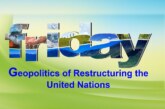
Dr. Arvind Kumar*

Europe is experiencing some of the hottest temperatures of summer 2023 so far, as a ‘heat dome’ expands over the southern half of the continent. While flying back from Geneva yesterday I saw all the mountains without ice caps, and then CNN confirmed that this summer Switzerland lost 4% of its glaciers. Since 1907 this summer has been the hottest for Geneva. Isn’t it frightening?
Article 6.4 of the Paris Agreement to the United Nations Framework Convention on Climate Change (“UNFCCC”) provides a structure for a carbon credit market on which greenhouse gas (“GHG”) emission reductions or removals may be transferred internationally. While the Parties to the Paris Agreement have agreed to basic elements regarding this market mechanism, negotiations continue on environmental criteria that Article 6.4 carbon credits must satisfy activities that can generate credits, methodologies that will apply, and safeguards to protect against adverse impacts. In addition, outstanding issues remain in relation to the administrative infrastructure needed for the Article 6.4 market mechanism to function. Discussions continued on these issues at the 58th session of the UNFCCC Subsidiary Body for Implementation and Subsidiary Body for Scientific and Technological Advice (“SBSTA”) from 5 to 15 June 2023 in Bonn, Germany (the “Bonn Climate Change Conference”), paving the way for further progress at the upcoming 28th session of Conference of the Parties to the UNFCCC (“COP”) in Dubai, United Arab Emirates starting in late November 2023 (“COP28”).
One of the provisions in Article 6.4 is to “incentivize and facilitate private sector involvement.” Paragraph 37a of decision 1/CP.21 “recommends” that rules, modalities, and procedures be adopted on the basis of “voluntary participation authorized by each Party involved.” This paragraph produces a clear limitation to the scope of A6.4M: private sector actors wishing to invest under the A6.4M will be required to obtain authorization from the Party where the mitigation action is located. What form this authorization will take is yet to be determined. In the CDM, the DNA was responsible for declaring the host country’s authorization of the project, in a letter of approval as well as providing authorization from an Annex 1 Party. As this is the Paris Agreement, and all Parties have obligations, the Annex I/non-Annex I diff erence will disappear. The complexity of how the authorization for participation will be granted, how and under what conditions it can be withdrawn will also play an important role of how much the A6.4M will be used. At its extreme, it may be a blanket approval for private entities to participate in A6.4M activities in a certain jurisdiction. At the other extreme, it may continue to be a project-by project approval, granted through a complex and uncertain process, with periodic review that is seen, or emerges, as arbitrary.
Are the rules airtight?
The rules largely reduce the risk of double counting, but are not completely airtight. The main tool for avoiding double counting is to apply “corresponding adjustments”, which are required for all authorized carbon credits. Rather like in double-entry bookkeeping, this involves the country selling carbon credits to deduct them from its own greenhouse gas inventory so that the country (or airline) buying them can count them towards its own climate targets. This clearly signals that double counting will not be tolerated in the official system. However, “voluntary” credits purchased by private companies do not have to go through the Article 6 system. This means that largely unregulated private schemes can still allow double counting, even though this defies logic and environmental integrity. It remains unclear whether buyers will even want double-counted credits when properly adjusted credits will be available. In addition, the way in which these adjustments will be applied to some varieties of credits is problematic. This is primarily the case when it comes to accounting for ITMOs under CORSIA, the carbon offsetting scheme for aviation. Countries with a single year target for their nationally determined contribution (NDC) – such as reducing emissions by x% by 2030 – which is the case of most countries, will apply adjustments in the target year as an average of all credits sold and purchased over the entire NDC period. Take a country that sells 0 credit over the first nine years of its NDC period, and then sells 100 credits to an airline for compliance under CORSIA during the 10th and last year of its NDC period. The airline will count 100 credits, but the selling country will only correct for the average quantity of credits sold over its NDC period, i.e. 100/10=10 credits. 90 credits are double-counted.

What implications do Article 6 rules have for the voluntary carbon market?
Any project seeking to register under Article 6.4 will need to comply with all 6.4 rules regardless of who buys the credits (company or country). All credits authorized by countries must be accounted for, including when sold to private companies.
However, the 6.4 text is unclear regarding the possibility of issuing credits that are not authorized, and hence not accounted for. If such credits were to be issued, it would amount to green washing for private companies to make offsetting claims from these “non-authorized” units. However, the vagueness of the text could be exploited in this way until countries clarify the situation. That said, such credits could legitimately be an avenue for companies to provide climate finance to support mitigation in developing countries, but not to claim ownership of those reductions and/or use them to advertise “net zero” claims.
In addition, other decisions will send a signal to the voluntary carbon market. Actors in these markets should take note that all countries who have ratified the Paris Agreement have agreed that, simple offsetting is no longer acceptable (2% of all A6.4ERs will be cancelled without anyone using them), and that credits must deliver climate adaptation finance (5% of all A6.4ERs will be given to the Adaptation Fund, which can re-sell them to generate revenues). More and more voices are calling for the voluntary carbon market to get in line with Article 6 by adopting this mandatory minimum 2% cancellation of credits (referred to as overall mitigation in global emissions, or OMGE), and this mandatory minimum 5% share of credits to support adaptation (referred to as share of proceeds, or SOP). Two UN negotiating groups representing 85 countries that are highly vulnerable to climate change, the Alliance of Small Island Developing States (AOSIS) and the Least Developed Countries (LDCs), have publicly called on the voluntary market to adopt mandatory minimum 2% OMGE and 5% SOP rates.
Do “avoided emissions” qualify under the new Article 6 rules?
Avoided emissions – whereby a project makes assumptions about how its existence could lead to future emissions being avoided – do not qualify as a basis to generate any kind of carbon credits under Article 6. A technical UN body has been tasked with assessing whether avoided emissions could be considered as a basis for generating credits in the future, but this is unlikely to change because most countries firmly oppose this, for good reason, owing to the significant risk associated with issuing credits from avoided emissions. For example, under the guise of emission avoidance, a fossil fuel extracting country or company or project developer, could potentially claim to pump less oil and gas (or to do less exploration) in order to sell carbon credits, which could in turn be used by another country or company to “reach” a climate target, even if such credits were environmentally worthless
Way Forward
Article 6 of the Paris Agreement was one of the most technical parts of the COP27 process. It is about cooperative approaches to cutting emissions, market and non-market based. While the Article 6 “rulebook” was completed at COP26 in Glasgow, COP27 faced decisions on the definitions and procedures that are still needed before any trading can begin. Several contentious issues were deferred, including how to treat emissions from “removals”, whether to allow credits for “emissions avoidance” and when carbon credits could be “revoked”. COP27 managed to deliver a significant amount of additional guidance that will help to operationalize Article 6. However, trading under Article 6 is unlikely to start before 2024 at the earliest, while the voluntary carbon markets may take off earlier. However, countries that are planning to take part in the Paris Agreement market mechanisms should already build the required national structures.
One generic issue of all the climate change treaties is the fact that currently countries calculate their total emissions and set targets based on what they produce within their borders such as from producing electricity or burning fuels. This means that they don’t count the emissions from the goods and services produced by another country for them. This is even though the developed nations import large amounts of manufactured products from developing countries. For example, if these “consumption-based” emissions were counted then the UK’s carbon footprint would more than double. In the cover decision for the first-time countries recognized “the importance of transition[ing] to sustainable patterns of consumption”. However, it is not clear yet how governments will translate this into national actions. This disparity needs to be counted and integrated with the complete spectrum.
*Editor, Focus Global Reporter



